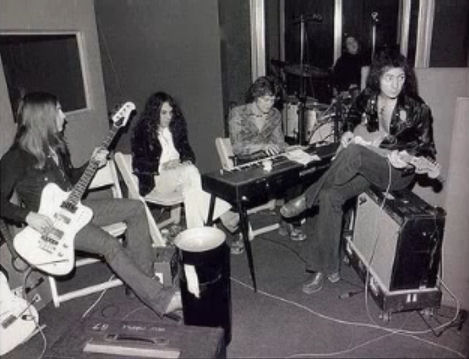Ritchie, the AIWA & the studios
For the live tour of “Burn”, Ritchie had whipped his live setup into shape. Following a factory modification, his marshall majors now matched his AIWA exactly which he started using as a booster and echo from now on. Everything seemed to work perfectly well. At the 1974 session of the “Stormbringer” album, however, RB increasingly distanced himself from DP; he felt somehow that the DP rock liner had come slowly but surely under the influence of the new members Coverdale & Hughes and was heading for funky bluesy waters. With a team like this one, it was now more and more difficult for Ritchie to have his views of straightforward rock asserted. From around December 1974, Ritchie made it understood that he would simply record the rejected songs which he auditioned to others in the meantime, such as “Man on the Silver Mountain”, with new people. Within a few months only, R would then show up at several recording studios with the AIWA and his natural ash-body strat. Also, always on board with him: Martin Birch at the mixer, who had brilliantly staged DP items in the past as well.
Well, DP was/is not just any band, because they have supergroup status, similar to ELP or Led Zeppelin. One would definitely think twice about dropping out from them. This was eventually all about contracts and also loads of dough! Anyway, RB was, understandably enough, a bit hesitating initially. First conceived as a one-off project, this matter gained momentum in a highly advantageous manner for Blackmore, not least owing to the fantastic singer Ronnie James Dio of band “ELF” which Ritchie had “acquired” except for their guitarist, and he ultimately even enjoyed playing with the new band.
Ritchie’s first studio album was thus created in several places together with ELF as the accompanying band. The album was plainly entitled: “Ritchie Blackmore’s Rainbow”. This constellation, however, was never to perform live. Unmodified marshalls were employed as boosters, and whether one of these came from Ritchie’s backup majors or from the studio can no longer be established. This is because Blackmore’s stage majors resounded at the same time as the ones presented in “Made in Europe” (April 1975), and this sound was basically different from Ritchie’s debut album. In spite of those different conditions, Birch managed to mix a perfect homogeneous work as to sounding. The sound that was by now pressed in the grooves by Martin, revealed upon closer listening R’s elegant guitar playing, served with a light crunch and hardly any sustain. The overall sound of “RBsR” was slightly peculiar, and rather stodgy to the ears of those used to listening to, for example, Led Zeppelin, Gallagher or The Who, the guitar featuring no distracting ornaments, with no screeching in the overtones, that is, well, a bit tame altogether.
In many tracks and riffs, volume control of his strat was a bit taken back (approx. #8), so that the bass of string #E6 would not even match #A5 of the strat in the amps deployed. In RB’s live setup, the preamp factory modification of his marshall majors sorted the “unmatching”. It should further be mentioned that Ritchie would quite frequently strum very close to the bridge or at least above the bridge pickup and for this very reason already generated a less bassy sound.
Ritchie, the AIWA & the Rainbow
After album “RBsR”, R then replaced the team immediately, except for the famous singer Ronnie James Dio, to record a new album and also to go on a world tour. This band configuration was to be called the “classical” Rainbow band later on. The new album of spring 1976 was called “Rising”, and the band was simply called “Rainbow”. Even if the individual records of RBsR were still a bit influenced by DP with whom Blackmore actually continued to play live until April 1975, Ritchie was now free! for the “Rising” album, that is, free from DP, free from explanations or even compromises. Well, yes, Ritchie’s debut album RBsR seemed a bit quiet but he just had to keep going, as the scene was not waiting! Young talents, such as Michael Schenker in conjunction with UFO, demonstrated from 1974 with songs like “Rock Bottom”, “Light´s out” or “Doctor, Doctor”, that they, too, were able to celebrate heavy rock in a hard and unfussy manner. The “Rising” sound of was then indeed really tough and hit you straight between the eyes, a truly fine heavy rock production, a Blackmore album, again remixed by Martin Birch. This time, RB had also brought his own majors to the studio, which were then serviced by his technician from 1976. The sound would be slightly modified over the years again and again, whereas more substantial changes were implemented in connection with pick replacements.
The first live recordings of Rainbow (as bootlegs) went back to a brief tour in November 1975. Although the sound over there was technically a bit flat, it was still all right for a live bootleg, and it clearly showed that RB’s majors still comprised the marshall factory modifications. In the official “live on stage” recordings or the “Germany live records” of equal good quality, Ritchie’s tone is more powerful and more “heavy”.
